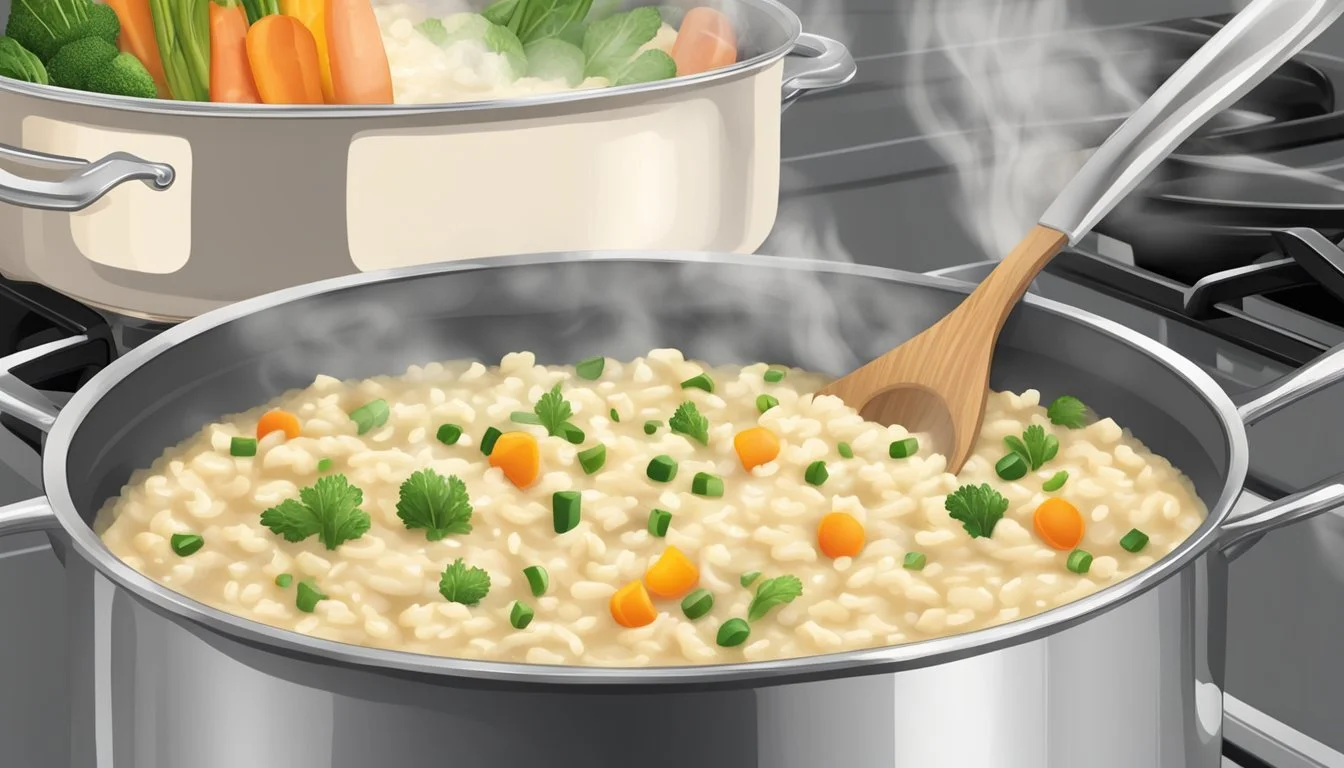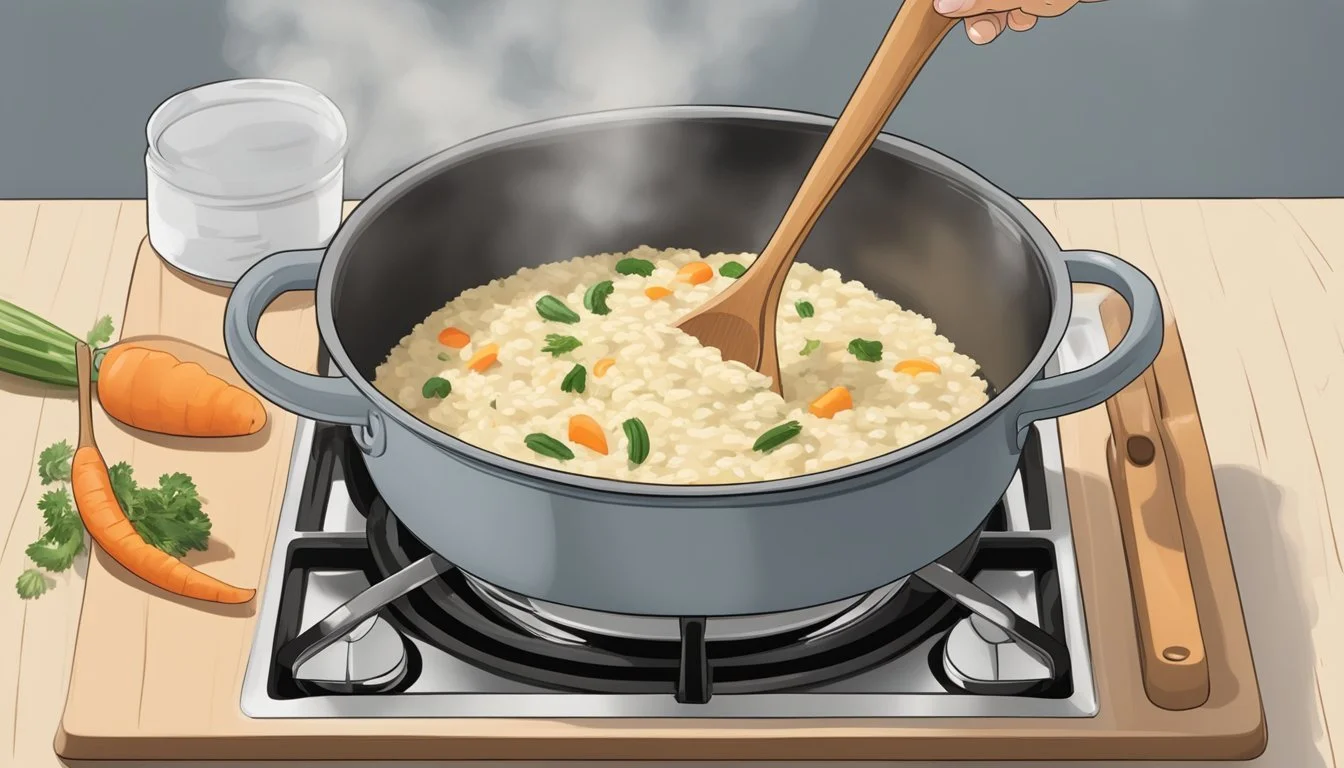Best Way to Reheat Risotto
Techniques for Preserving Creaminess and Tender Veggies
Risotto, the classic Italian dish known for its creamy texture and rich flavors, is a meal that often leaves behind leftovers due to its typically generous portions. Reheating risotto can be tricky, as it requires the right technique to restore its creamy consistency without overcooking the rice or turning the vegetables to mush. The goal when reheating is to maintain, if not enhance, the dish's original taste and texture.
Several methods exist for reheating risotto effectively, ranging from the stovetop to the microwave or even the oven. Each technique has its own set of advantages, ensuring that the arborio rice—which is known for its ability to absorb flavors and retain a bite ("al dente")—remains the dish's star. Meanwhile, it's crucial to pay attention to the vegetables and other add-ins, which need to be warmed through while still retaining their tenderness and vibrant color.
The best way to reheat risotto involves adding a bit of liquid to the rice to reinvigorate its creamy texture. This liquid can be broth, water, or wine, depending on the original recipe and what's available. Slowly warming the dish while frequently stirring helps redistribute the warmth and creaminess throughout, resulting in a reheated risotto that closely resembles the freshly made experience.
Understanding Risotto
Risotto is an Italian rice dish known for its creamy texture and rich flavors, primarily achieved through the careful selection of ingredients and the unique method of preparation. This classic dish not only demands attention while cooking but also when reheating to maintain its signature qualities.
Key Ingredients
Rice: Arborio rice, a short-grain variety originating from Italy, is the traditional choice for risotto due to its high starch content, which contributes to the creaminess of the dish.
Liquid: A mixture of chicken or vegetable broth alongside a splash of dry white wine is gradually added to the rice, enhancing the flavor and contributing to the creamy texture.
Alliums: The base flavor often starts with onion and garlic, sautéed until translucent.
Fats: Butter is typically used at the beginning for sautéing and at the end to finish the dish, adding to the richness.
Cheese: Parmesan cheese is stirred in before serving, giving risotto its signature savory depth.
Risotto Texture and Composition
Risotto's texture should be creamy, yet the rice grains should retain a slight bite, known as 'al dente'. The slow cooking and constant stirring promote the release of starch, binding the rice and liquid into a harmonious and creamy consistency without the need for cream.
Potential Risks of Reheating Incorrectly
Reheating risotto improperly can lead to several issues:
Dryness: Without the correct addition of liquid, the creamy texture can become dry and stodgy.
Overcooking: Excessive heat can further soften the rice, resulting in a mushy texture and loss of the 'al dente' bite.
Separation: High heat can cause the fats and liquid to separate, diminishing the homogenous creamy quality of the dish.
Vegetable texture: If the risotto includes vegetables, incorrect reheating can make them too soft or overcooked, compromising the dish's integrity.
Pre-Reheating Steps
Before attempting to reheat risotto, one must ensure it has been stored and prepared properly to maintain texture and flavor.
Storing Risotto Properly
Leftover risotto should be stored in the fridge as soon as it cools to room temperature. Ideally, it should be placed in an airtight container, which can preserve its moisture and prevent the rice from drying out. Avoid using aluminum foil or plastic wrap directly on the risotto as they may not provide an airtight seal. When storing risotto, prompt refrigeration is key—usually within two hours of cooking—to ensure food safety and maintain quality.
Thawing Frozen Risotto
If the leftover risotto was stored in the freezer for longer shelf life, it should be thawed properly to ensure even reheating. To thaw frozen risotto, transfer it to the refrigerator a day before reheating to allow it to defrost slowly. Thawing at room temperature is not recommended, as it can lead to bacterial growth. Once thawed, the risotto will be ready to be reheated, retaining more of its creamy texture and the tenderness of any vegetables in it.
Reheating Techniques
Ensuring risotto retains its creamy texture and tender vegetables requires careful reheating. Three effective methods are discussed below: on the stove, in the oven, and in the microwave.
Stovetop Reheating
For stove reheating, one needs to combine gentleness with constant attention. The stove should be set to medium heat. Adding liquid is crucial; approximately 2 to 3 tablespoons of broth or water per cup of risotto will suffice. One then transfers the risotto to a skillet, pouring in the liquid. It's important to stir frequently, allowing the risotto to reheat evenly and regain its creamy consistency.
Oven Reheating
When reheating in the oven, one should preheat it to 300°F to gently warm the risotto. A baking dish is used to spread out the risotto, and a splash of water or stock is stirred in to keep moisture levels optimal. Covering the dish with a lid or foil is wise, to trap the steam. The risotto typically needs 10-15 minutes to heat through properly on low heat.
Microwave Reheating
To reheat risotto in the microwave, one should place the risotto in a microwave-safe dish and sprinkle it with a little additional water or stock to aid in moisturizing. Covering with a paper towel or a lid that's not fully secured can help avoid splatters. The dish should be heated on high power for short intervals, stirring every 30-60 seconds, until the risotto recovers its desired warm, creamy texture.
Maintaining Quality and Safety
When reheating risotto, one must pay careful attention to temperature control to maintain the dish's quality while safeguarding against food poisoning due to bacterial growth. By carefully managing the reheating process, one can preserve the creamy texture of the rice and tender quality of any vegetables, ensuring leftovers are both safe and enjoyable.
Avoiding Overheating
Temperature management is crucial to avoid overheating, which can dry out risotto and cause the rice to become mushy:
When reheating on the stove, use a low to medium heat setting.
Stir the risotto frequently to ensure even heating and prevent sticking or burning.
If using a microwave, heat in short intervals, stirring between each to promote uniform temperature distribution.
Preventing Bacterial Growth
To inhibit bacterial growth and reduce the risk of food poisoning:
Storage: Cool risotto quickly and store it in the refrigerator within two hours of cooking.
Temperature Range Action Above 140°F Safe zone for serving and eating risotto immediately after cooking. Below 40°F Safe zone for refrigerated storage of leftover risotto.
Reheating:
Always reheat risotto to an internal temperature of at least 165°F for food safety.
Utilize a food thermometer to check the temperature at the center of the dish.
Leftovers should ideally be consumed within 1-2 days to minimize the risk of bacterial growth.
Advanced Reheating Tips
Reheating risotto requires finesse to maintain its creamy consistency and the vegetables' tenderness. The secret lies in the method and ingredients used to reintroduce moisture to the dish.
Adding Moisture
When reheating risotto, additional moisture compensates for the inevitable dryness that occurs after storage. A gentle approach involves adding a small amount of liquid to the risotto before heating:
Liquid Choices: Use options like low-sodium chicken or vegetable broth to complement the flavor profile. Alternatively, a splash of water can suffice.
Quantities: For each cup of risotto, mix in approximately 2-3 tablespoons of liquid.
Incorporation: Stir the liquid into the risotto to ensure even distribution.
Olive oil or butter can also be mixed in to enhance flavor and richness. They should be warmed and then gently folded into the risotto, not only to add creaminess but also to prevent stickiness as the rice reheats.
Utilizing Leftovers Creatively
Leftover risotto can be transformed into new dishes while reheating:
Risotto Fritters: Form cold risotto into small patties, coat with bread crumbs, and pan-fry until golden brown.
Arancini: These delightful rice balls encase a piece of cheese inside the risotto before being rolled in breadcrumbs and deep-fried.
Both methods leverage the cohesive texture of cold risotto and introduce a textural contrast with a crispy exterior while reheating the interior.
Steaming: To reheat risotto while preserving moisture and texture, one can use a steamer basket:
Fill a pot with a small amount of water and bring it to a boil.
Place risotto in a bowl that fits inside the basket.
Lower the heat to a simmer, place the bowl in the basket, cover, and steam until heated through.
Covering the top of the rice with a damp paper towel before placing it in the basket can provide extra moisture and help the risotto heat evenly.
By following these tips, one ensures the best methods for reheating risotto are utilized, keeping the rice creamy and the vegetables tender.
Serving and Pairing
Reheated risotto, with its creamy consistency and tender vegetables, pairs splendidly with a variety of accompaniments and wines that can elevate it to a complete and sophisticated meal.
Accompaniments and Wine Pairing
When serving risotto, one can enhance the dining experience with thoughtful accompaniments and wine selections. Side dishes such as a crisp green salad or roasted vegetables complement the creaminess of the risotto and provide a balance in flavor and texture. For wine pairing, a light-bodied white wine like a Pinot Grigio or a Chardonnay pairs exceptionally well, as their acidity balances the richness of the dish.
Recommended Wine Pairings:
Pinot Grigio
Chardonnay
To incorporate spices and cooking tips that go hand in hand with reheated risotto, consider garnishing with fresh herbs such as thyme or basil. These not only add a pop of color but also infuse the dish with aromatic freshness.
Transforming Risotto into a Main Course
Risotto can easily be transformed into a main course by incorporating a protein such as grilled chicken or sautéed shrimp. When reheating the risotto, one may stir in cooked protein towards the end to avoid overcooking it, maintaining the desired texture.
Suggestions for Main Course Additions:
Grilled Chicken
Sautéed Shrimp
To further tailor the risotto into a heartier main dish, one may consider stirring in sautéed mushrooms or spinach, which contribute both flavor and substance. This elevates the risotto from a mere side dish to the star of the meal, satisfying and complete on its own.
Conclusion
Reheating risotto requires a careful approach to maintain its creamy texture and prevent overcooking of vegetables. The methods mentioned offer versatility to suit different preferences and kitchen resources.
Microwave: An expedient method, ideal for those who want to save time. Add a bit of liquid (water, broth, or wine) and butter or cheese for richness, then cover and reheat in short intervals, stirring occasionally.
Stovetop: Suited for a creamy, restaurant-style finish. Stirring in a small amount of broth gradually can help restore the risotto's lush consistency.
Oven: Useful when reheating larger quantities. Moisturizing with broth and covering with foil before heating in the oven can yield excellent results.
Regardless of the method, one should always be attentive to the risotto's moisture level and stir frequently to revive its creaminess without making it mushy. They must also consider the vegetables' tenderness, especially if they're part of the dish, to avoid overcooking.
In short, whether a novice or a seasoned cook, they can reheat risotto to a delightful state with a little attention and the right technique. It's all about adding moisture, applying gentle heat, and stirring to achieve that perfect creamy risotto texture once again.




